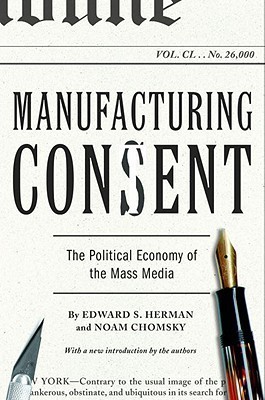More on this book
Community
Kindle Notes & Highlights
Read between
August 28 - September 26, 2024
In sum, the dominant media firms are quite large businesses; they are controlled by very wealthy people or by managers who are subject to sharp constraints by owners and other market-profit-oriented forces;40 and they are closely interlocked, and have important common interests, with other major corporations, banks, and government.
With advertising, the free market does not yield a neutral system in which final buyer choice decides.
In effect, the large bureaucracies of the powerful subsidize the mass media, and gain special access by their contribution to reducing the media’s costs of acquiring the raw materials of, and producing, news. The large entities that provide this subsidy become “routine” news sources and have privileged access to the gates. Non-routine sources must struggle for access, and may be ignored by the arbitrary decision of the gatekeepers.
“Concentrate on the victims of enemy powers and forget about the victims of friends.”
The media not only suspend critical judgment and investigative zeal, they compete to find ways of putting the newly established truth in a supportive light. Themes and facts—even careful and well-documented analyses—that are incompatible with the now institutionalized theme are suppressed or ignored. If the theme collapses of its own burden of fabrications, the mass media will quietly fold their tents and move on to another topic.
We would also expect great investigatory zeal in the search for enemy villainy and the responsibility of high officials for abuses in enemy states, but diminished enterprise in examining such matters in connection with one’s own and friendly states.
When U.S. forces burned villages, this was a necessity because they provided cover and support for the Viet Cong. The results of B-52 saturation bombing were a “tragedy of war.” But when a North Vietnamese artillery shell hit an orphanage in An Hoa in October 1970, ABC’s George Watson commented with horror: “No one was prepared for the massacre, the irrational murder that the North Vietnamese inflicted on An Hoa.”
With regard to the American war, the PBS series makes a conscious effort to be balanced, to present all sides, to take no side. The French, in contrast, are treated far more harshly, as brutal colonialists, with no pretense of balance. Peter Biskind comments: Whereas the narrator referred to Ho Chi Minh and his followers as “rebels,” “nationalists,” or “the Vietnamese resistance,” as long as they were fighting the French, once the Americans arrive they are invariably “Communists” or just “the enemy.” Whereas Bao Dai is the “playboy emperor picked by the French,” Nguyen Cao Ky and Nguyen Van
...more
Given the imperatives of corporate organization and the workings of the various filters, conformity to the needs and interests of privileged sectors is essential to success.
A propaganda model, we believe, captures essential features of the process, but it leaves many nuances and secondary effects unanalyzed. There are other factors that should be recognized. Some of these conflict with the “societal purpose” of the media as described by the propaganda model; some support it. In the former category, the humanity and professional integrity of journalists often leads them in directions that are unacceptable in the ideological institutions, and one should not underestimate the psychological burden of suppressing obvious truths and maintaining the required doctrines
...more
But a critical analysis of American institutions, the way they function domestically and their international operations, must meet far higher standards; in fact, standards are often imposed that can barely be met in the natural sciences. One has to work hard, to produce evidence that is credible, to construct serious arguments, to present extensive documentation—all tasks that are superfluous as long as one remains within the presuppositional framework of the doctrinal consensus. It is small wonder that few are willing to undertake the effort, quite apart from the rewards that accrue to
...more
The critic must also be prepared to face a defamation apparatus against which there is little recourse, an inhibiting factor that is not insubstantial.
In sum, the mass media of the United States are effective and powerful ideological institutions that carry out a system-supportive propaganda function by reliance on market forces, internalized assumptions, and self-censorship, and without significant overt coercion. This propaganda system has become even more efficient in recent decades with the rise of the national television networks, greater mass-media concentration, right-wing pressures on public radio and television, and the growth in scope and sophistication of public relations and news management.
Brian liked this
The rise of cable and satellite communications, while initially captured and dominated by commercial interests, has weakened the power of the network oligopoly and retains a potential for enhanced local-group access. There are already some 3,000 public-access channels in use in the United States, offering 20,000 hours of locally produced programs per week, and there are even national producers and distributors of programs for access channels through satellites (e.g., Deep-Dish Television), as well as hundreds of local suppliers, although all of them must struggle for funding.


